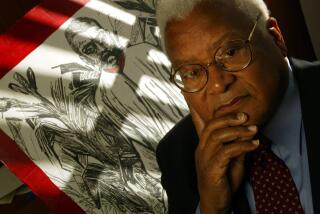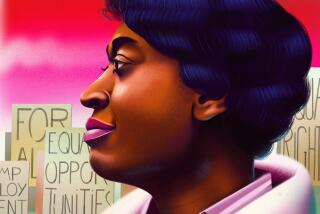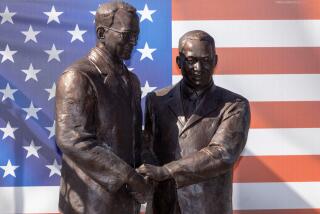In Memory of Battles Past : New museum commemorates the most intense years of the modern civil rights struggle
With the vocabulary of civil rights shifted from “desegregation” and “lunch counter sit-ins” to “affirmative action” and “diversity hiring goals,” Americans are increasingly trying to acknowledge their ignominious history in the area of civil rights.
For instance, Congress is considering legislation to establish a national historic park at Manzanar, Calif., home of one of the first World War II internment camps for Japanese Americans. And last week, more than 100 civil rights legends, including Rosa Parks and Coretta Scott King, gathered in Memphis to dedicate the National Civil Rights Museum on the site of the Lorraine Motel, where Martin Luther King Jr. died from an assassin’s bullet. The museum is a 10-year, $10-million project built with a combination of city, state, county and private funds. It commemorates the most intense years of the modern civil rights struggle, between the U.S. Supreme Court’s landmark 1954 decision in Brown vs. Board of Education, outlawing segregated public schools, and King’s assassination in 1968. It will open to visitors in late summer.
Many other places significant in African-American history have been designated as monuments, but the Memphis museum is different. Visitors will “feel the horror the demonstrators experienced,” according to D’Army Bailey, head of the museum’s foundation. They can board a 1950s Montgomery, Ala., bus. But if they sit in a “whites only” seat, as did Rosa Parks in 1955, a recorded voice will harshly and repeatedly order them to the rear. Visitors can cross a replica of the Edmund Pettus Bridge outside Selma, passing between life-size photos of armed troopers; demonstrators had tried to cross the bridge but were beaten back during a 1965 march to Montgomery. They can sit at a lunch counter, amid statues of student protesters and two jeering white men. They can see Dr. King’s motel room, furnished as it was in 1968, the doorway leading to the second-floor balcony and the bloodstained concrete where he fell.
For younger generations, Bailey said the museum should inspire and “ignite another generation of protest. . . . Kids should understand that . . . you don’t have to be a Martin Luther King to make a change.” For Americans who have a firsthand knowledge of the modern fight for equal rights, the museum will serve as a “national center of remembrance for those who helped, who suffered and who struggle still.”
More to Read
The biggest entertainment stories
Get our big stories about Hollywood, film, television, music, arts, culture and more right in your inbox as soon as they publish.
You may occasionally receive promotional content from the Los Angeles Times.










